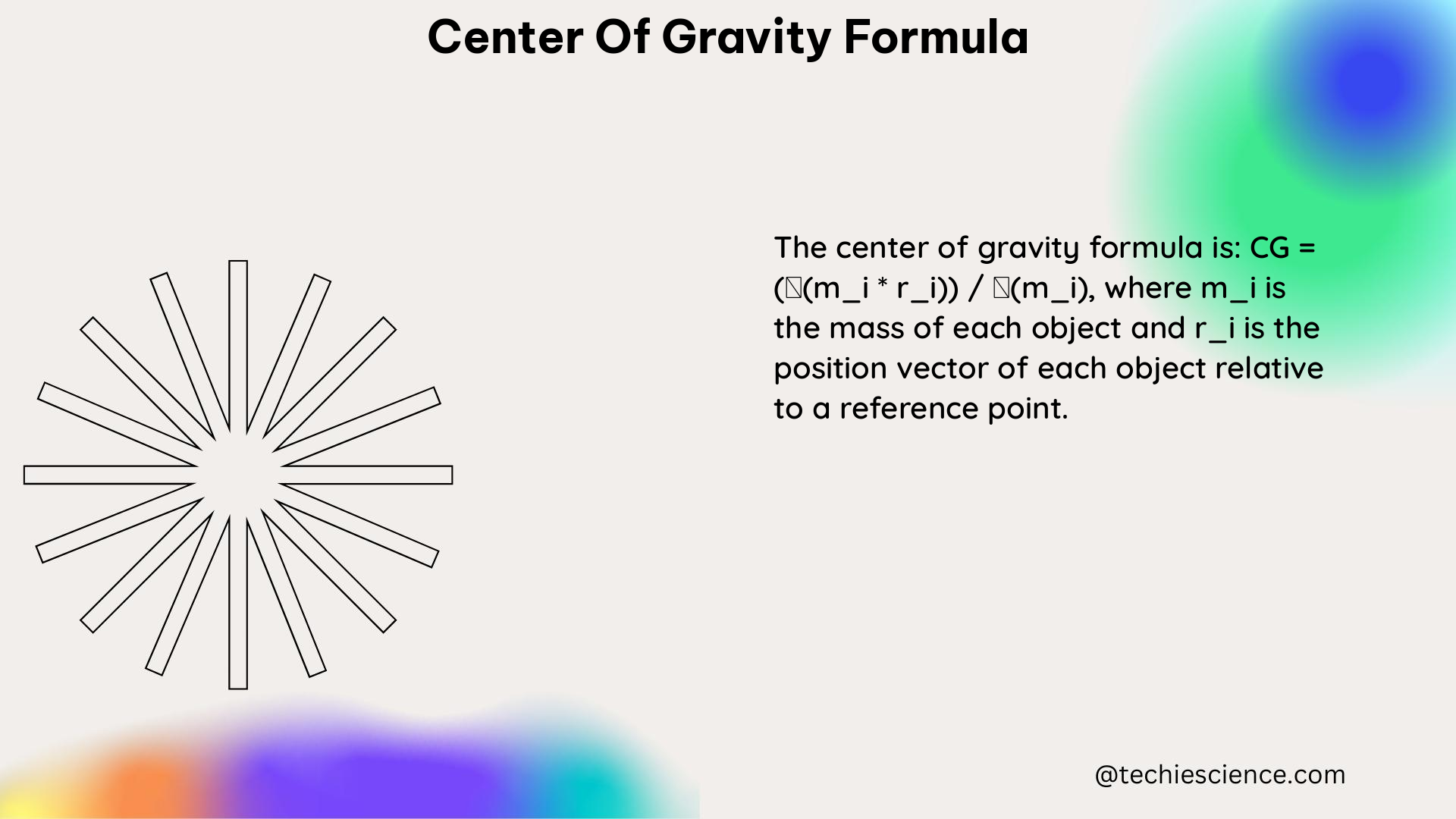The center of gravity (CG) is a fundamental concept in physics, crucial for understanding the behavior and stability of objects, particularly in the context of vehicle dynamics. This comprehensive guide delves into the intricacies of the center of gravity formula, providing a detailed exploration of the underlying principles, measurable data, and practical applications.
Understanding the Center of Gravity Formula
The center of gravity formula is expressed as:
[CG = \frac{\sum D \times W}{\sum W}]
Where:
– (CG) represents the location of the center of gravity
– (D) is the distance from the datum (a reference point)
– (W) is the weight of each object or component
This formula allows us to determine the precise location of the center of gravity, which is the point where the force of gravity can be considered to act on an object. Understanding the center of gravity is essential for analyzing the stability, handling, and performance of various systems, from vehicles to mechanical structures.
Measurable Data for Center of Gravity Calculations

To effectively apply the center of gravity formula, we need to gather and analyze specific measurable data. Let’s explore the key data points:
Weight Distribution
Accurately measuring the weight distribution of an object or system is crucial for determining the center of gravity. The weight distribution data should include the following:
| Location | Weight (kg) |
|---|---|
| Front Left Corner | 88 |
| Front Right Corner | 92 |
| Rear Left Corner | 123 |
| Rear Right Corner | 122 |
| Front Weight Percent | 42.35% |
| Left Weight Percent | 49.64% |
| Total Weight | 425 kg |
Dimensional Measurements
The dimensions of the object or system also play a significant role in the center of gravity calculations. The key dimensional data points include:
- Wheelbase: 2.65 m
- Front Track Width: 1.45 m
- Rear Track Width: 1.45 m
Height and Angle Measurements
In addition to the weight distribution and dimensional data, the vertical height and angle measurements are essential for determining the center of gravity’s vertical coordinate (z-axis).
- Vertical Height Raised: 0.819 m
- Angle of Raise: 18 degrees
Longitudinal and Vertical Coordinates
Using the center of gravity formula and the gathered data, we can calculate the longitudinal coordinate (x-axis) and the vertical coordinate (z-axis) of the center of gravity.
- Longitudinal Coordinate (x): Calculated using the formula
- Vertical Coordinate (z): Calculated using the formula
Example Calculations
Let’s walk through the step-by-step process of calculating the center of gravity using the provided data.
Longitudinal Coordinate (x)
- Calculate the moment for each object by multiplying its distance from the datum by its weight.
- Sum the moments and divide by the total weight to find the CG along the x-axis.
Vertical Coordinate (z)
- Measure the hub heights and weight distribution.
- Calculate the angle of raise using the triangle formed by the wheelbase and the height the rear wheels are raised.
- Plug all the values into the formula to find the CG height.
Key Principles and Applications
The center of gravity is a fundamental concept in physics, with several important principles and applications:
-
Point of Balance: The center of gravity is the point where the force of gravity can be considered to act, and it is the point of perfect balance, regardless of the object’s orientation.
-
Stability and Handling: Understanding the center of gravity is crucial for analyzing the stability and handling characteristics of vehicles, particularly in terms of cornering, braking, and rollover resistance.
-
Structural Design: The center of gravity is an essential consideration in the design of mechanical structures, such as cranes, bridges, and buildings, to ensure their stability and load-bearing capacity.
-
Aerospace Engineering: In the field of aerospace engineering, the center of gravity is a critical factor in the design and performance of aircraft, rockets, and spacecraft, affecting their stability, control, and overall flight dynamics.
-
Robotics and Automation: The center of gravity is a crucial consideration in the design and control of robotic systems, ensuring their stability and maneuverability in various environments.
Conclusion
The center of gravity formula is a powerful tool for understanding the behavior and stability of objects in physics and engineering. By mastering the concepts and techniques presented in this comprehensive guide, physics students can develop a deep understanding of this fundamental principle and apply it to a wide range of practical applications.
References
- Suspension Secrets. (n.d.). How to Calculate Centre of Gravity Position. Retrieved from https://suspensionsecrets.co.uk/how-to-calculate-centre-of-gravity-position/
- Raptor Scientific. (n.d.). Center of Gravity. Retrieved from https://raptor-scientific.com/resources/center-of-gravity/
- WikiHow. (n.d.). How to Calculate Center of Gravity. Retrieved from https://www.wikihow.com/Calculate-Center-of-Gravity
- Car and Driver. (2018). Explained: How to Measure Center of Gravity Height. Retrieved from https://www.caranddriver.com/news/a18201745/explained-how-to-measure-center-of-gravity-height/
- YouTube. (2018). How to Measure Center of Gravity. Retrieved from https://www.youtube.com/watch?v=ZyGC1JgANbA

The lambdageeks.com Core SME Team is a group of experienced subject matter experts from diverse scientific and technical fields including Physics, Chemistry, Technology,Electronics & Electrical Engineering, Automotive, Mechanical Engineering. Our team collaborates to create high-quality, well-researched articles on a wide range of science and technology topics for the lambdageeks.com website.
All Our Senior SME are having more than 7 Years of experience in the respective fields . They are either Working Industry Professionals or assocaited With different Universities. Refer Our Authors Page to get to know About our Core SMEs.